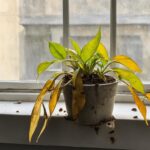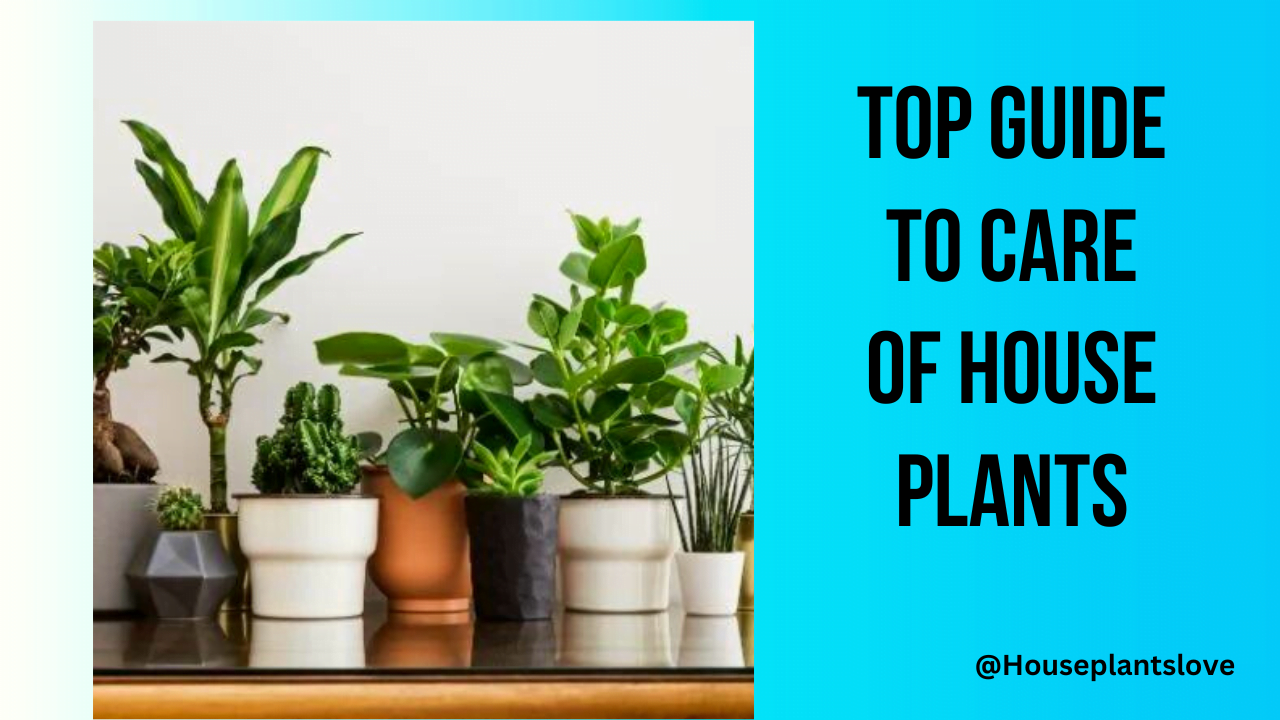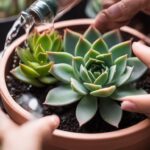Fiddle Leaf Fig Care: grow, Care, type, Water, Soil, identity, light, season, Bugs, Fertilizer, Planter Size, issue, Drainage, humidity, propogation
Hey there! Are you looking to add a touch of green to your home? Look no further than the Fiddle Leaf Fig. As a plant lover myself, I know the importance of providing the right care for our leafy friends. In this article, I will guide you through the essentials of caring for your Fiddle Leaf Fig. We’ll cover topics such as planter size, soil requirements, drainage, and fertilizing, as well as common issues that may arise. It is one of the Trending Indoor Plants for 2024
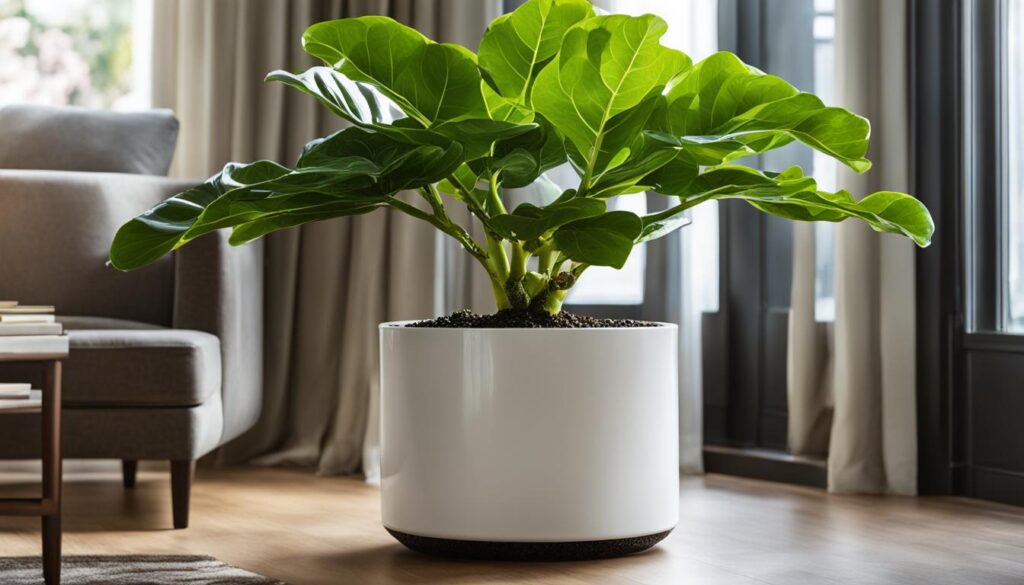
Types of Fiddle Leaf Figs
Fiddle Leaf Figs, scientifically known as Ficus lyrata, are native to the rainforests of western and central Africa. They are beloved for their large, oval-shaped green leaves that resemble the size and shape of a fiddle. These ornamental plants are slow-growing but can reach heights of up to 10 feet indoors.
- Fiddle Leaf Fig Plant
- Ficus Audrey
- Variegated Rubber Plant
- Bambino/Dwarf Fiddle Leaf Fig
- Variegated Fiddle Leaf Fig
The Fiddle Leaf Fig ‘Bambino’ is a dwarf variety of the popular Fiddle Leaf Fig plant. It is characterized by its small, violin-shaped leaves and compact size. ‘Bambino’ plants typically reach a height of 3 to 4 feet, making them perfect for smaller spaces. They have a full, bushy growth habit and their leaves are about 4 to 6 inches long. The glossy green leaves with prominent veining add to the aesthetic appeal of this plant.
The Fiddle Leaf Fig ‘Bambino’ is a visually stunning plant with its small leaves and compact size. Its full growth habit and glossy green leaves make it a perfect addition to any indoor space. Whether you have limited space or simply prefer the smaller leaves of the ‘Bambino’, this variety offers all the beauty of a Fiddle Leaf Fig in a more manageable size.
| Key Features | Description |
|---|---|
| Leaf Size | 4 to 6 inches long |
| Plant Size | 3 to 4 feet in height |
| Growth Habit | Full and bushy |
| Leaf Color | Glossy green with prominent veining |
Seasonal Tips for Fiddle Leaf Fig Care
In order to ensure the healthy growth and development of your Fiddle Leaf Fig, it’s important to provide the proper care according to the seasons. Fiddle Leaf Figs are sensitive to temperature changes and prefer a consistent environment. Here are some seasonal tips to help you maintain the well-being of your Fiddle Leaf Fig:
Temperature Control
Fiddle Leaf Figs thrive in temperatures between 60⁰F – 80°F. It’s important to avoid exposing them to drafty areas or sudden temperature fluctuations, as this can cause stress and damage to the plant. Maintaining a stable and moderate temperature will promote optimal growth and prevent any adverse effects on your Fiddle Leaf Fig.
Spring and Summer Care
During the growing season, which typically occurs in spring and summer, your Fiddle Leaf Fig requires extra attention and care. This is the time when the plant actively produces new leaves and requires additional nutrients. To encourage leafy growth, use a slow-release fertilizer with a high nitrogen content. This will provide the necessary nutrients for healthy foliage and overall plant vigor.
Fall and Winter Care
As the seasons transition into fall and winter, Fiddle Leaf Figs enter a dormant period. During these months, growth slows down, and the plant requires less water and nutrients. Reduce your watering frequency to prevent overwatering and adjust your fertilization routine accordingly. It’s important to monitor the soil moisture levels and only water when the top two inches of soil are dry to the touch.
Seasonal Tips Table
| Season | Temperature | Care |
|---|---|---|
| Spring and Summer | 60⁰F – 80°F | Use a slow-release fertilizer high in nitrogen to encourage leafy growth. |
| Fall and Winter | 60⁰F – 80°F | Reduce watering frequency and adjust fertilization routine for the dormant period. |
By following these seasonal tips, you can ensure that your Fiddle Leaf Fig remains healthy and thrives throughout the year. Remember to provide the right temperature conditions, adjust watering and fertilization according to the season, and give your plant the care it needs for optimal growth. Enjoy the beauty and elegance of your Fiddle Leaf Fig all year round!
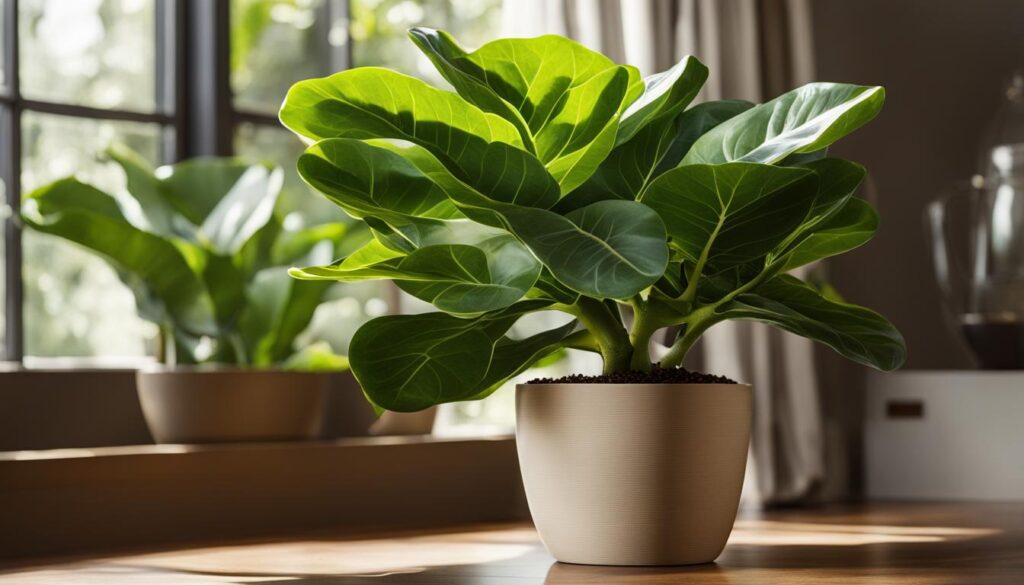
Light Requirements for Fiddle Leaf Fig
In order for your Fiddle Leaf Fig to thrive, it requires the right amount of light. Providing the appropriate light conditions will ensure the plant’s growth and overall health.
Fiddle Leaf Fig prefers bright, indirect light. Placing the plant near a window where it can receive filtered sunlight is ideal. However, it’s important to avoid exposing it to prolonged direct sunlight, as this can result in leaf scorching.
If your space lacks sufficient natural light, you can supplement it with artificial lighting. Full-spectrum grow lights or LED lights designed specifically for plant growth can be used to provide the necessary light for your Fiddle Leaf Fig.
Here’s a summary of the light requirements for Fiddle Leaf Fig:
| Light Requirement | Details |
|---|---|
| Bright, indirect light | Place near a window with filtered sunlight |
| Direct sunlight | Avoid prolonged exposure to prevent leaf scorching |
| Artificial lighting | Supplement with full-spectrum grow lights or LED lights |
Watering Fiddle Leaf Figs
Proper watering is key to maintaining healthy Fiddle Leaf Figs. As a general rule, I recommend watering your Fiddle Leaf Fig once a week, allowing the top two inches of soil to dry out between waterings. This helps prevent overwatering, which can lead to root rot, a common issue with these plants.
To check if your Fiddle Leaf Fig needs water, simply insert your finger into the soil. If it feels dry up to the second knuckle, it’s time to water. If the soil still feels moist, it’s best to wait a few more days before watering again. Remember, it’s always better to underwater than overwater.
When watering, make sure to thoroughly moisten the soil until water starts draining from the bottom of the pot. This ensures that the water reaches the plant’s roots and that excess water doesn’t accumulate, which can cause root rot.
It’s also worth noting that environmental factors such as temperature and humidity can affect your Fiddle Leaf Fig’s water needs. During hot and dry periods, you may need to increase the frequency of watering, while in cooler and more humid conditions, you may need to decrease it.
Watering Schedule for Fiddle Leaf Figs:
| Temperature | Watering Frequency |
|---|---|
| 60°F – 70°F | Once every 7-10 days |
| 70°F – 80°F | Once every 5-7 days |
| Above 80°F | Twice a week |
Soil Requirements for Fiddle Leaf Figs
When it comes to creating the ideal soil conditions for your Fiddle Leaf Fig, it’s important to prioritize proper drainage. Fiddle Leaf Figs prefer well-draining soil that allows excess water to flow out of the pot. This helps prevent root rot and ensures the plant receives the right amount of moisture.
One effective soil mixture for Fiddle Leaf Figs includes a combination of peat moss, perlite, and regular potting soil. The peat moss helps retain moisture while also providing good aeration, while perlite improves drainage by creating air spaces in the soil. The regular potting soil provides nutrients and stability to the mixture.
Avoid using compacted soil that retains too much moisture, as this can lead to root rot and other issues. It’s important to strike the right balance between moisture retention and proper drainage to keep your Fiddle Leaf Fig healthy and thriving.
| Soil Mixture | Benefits |
|---|---|
| Peat moss, perlite, and regular potting soil | – Enhanced drainage – Moisture retention – Nutrient-rich |
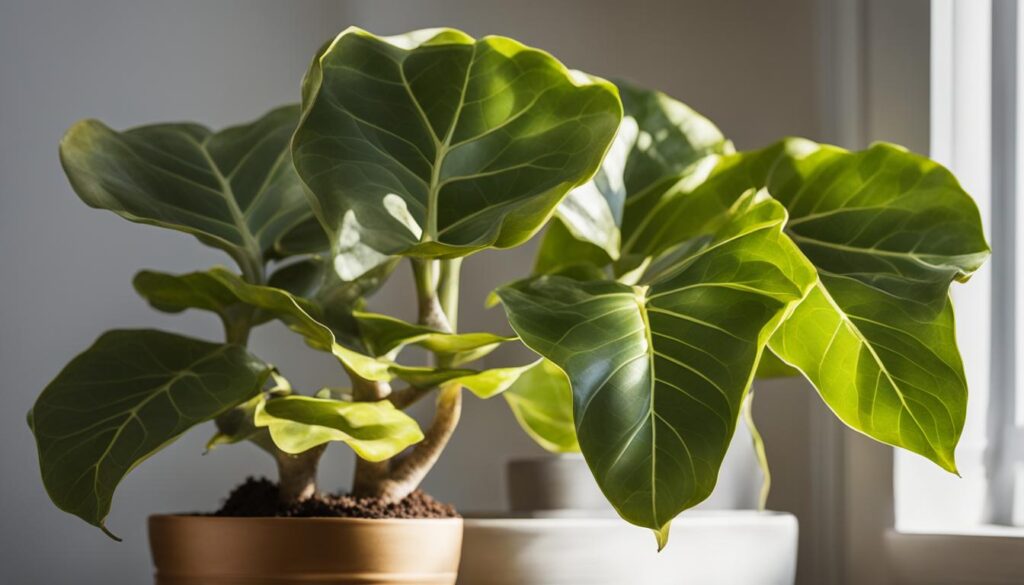
Fertilizer and Pruning Tips for Fiddle Leaf Figs
To keep your Fiddle Leaf Fig thriving, regular fertilization is essential. During the growing season, I recommend using a slow-release fertilizer with a nitrogen-rich formula. This will provide the plant with the necessary nutrients for healthy growth and vibrant leaves. Be sure to follow the instructions on the fertilizer packaging for the correct amount and frequency of application.
In addition to fertilization, pruning is another important aspect of Fiddle Leaf Fig care. Pruning not only helps to shape the plant but also promotes new growth and removes any damaged or yellowing leaves. It is best to prune your Fiddle Leaf Fig in the spring or early summer when the plant is actively growing. Use clean and sharp pruning shears to make clean cuts just above a leaf node or branch junction.
When pruning, focus on removing any dead, diseased, or leggy branches to maintain a compact and attractive shape. Pay attention to any leaves that are showing signs of discoloration or damage, as these can be indicators of underlying issues. Regular pruning will keep your Fiddle Leaf Fig looking healthy and well-maintained.
Propagation Tips for Fiddle Leaf Fig ‘Bambino’
Propagating your Fiddle Leaf Fig is a rewarding way to expand your plant collection or share the joy of growing with friends and family. There are two popular methods for propagating this plant: stem cuttings and air layering. Let’s explore each method in detail:
1. Stem Cuttings
Stem cuttings are a straightforward and effective way to propagate Fiddle Leaf Fig ‘Bambino’.
- Select a healthy stem with several leaves on it.
- Make a clean cut just below a node, which is the point where the leaf connects to the stem.
- Remove the lower leaves, leaving only a few leaves at the top.
- Dip the cut end in a rooting hormone to stimulate root growth.
- Plant the cutting in a well-draining potting mix, ensuring that at least one node is below the soil surface.
- Place the cutting in a warm and humid location with bright, indirect light.
- Mist the cutting regularly to maintain humidity and promote healthy root development.
- After a few weeks, you should start to see new roots forming. Once the roots are well-established, you can transplant the cutting into its own pot with well-draining soil.
2. Air Layering
Air layering is a slightly more advanced propagation method but can yield excellent results.
- Choose a healthy stem and remove a portion of the outer bark and cambium layer.
- Apply a rooting hormone to the exposed area to encourage root development.
- Wrap the exposed area with moist sphagnum moss and secure it with plastic wrap.
- Wait patiently for roots to develop. This process can take several weeks.
- Once roots have formed, carefully remove the plastic wrap and moss, keeping the roots intact.
- Plant the rooted stem in a separate container filled with well-draining soil.
Both methods require a well-draining potting mix to ensure proper moisture balance for the developing roots. Remember to keep the soil consistently moist but not waterlogged.
Propagating your beloved Fiddle Leaf Fig ‘Bambino’ can be a fun and rewarding experience. Whether you choose stem cuttings or air layering, with a little patience and ca re, you’ll soon have new thriving plants to enjoy or share with fellow plant enthusiasts.
Common Issues with Fiddle Leaf Figs
Fiddle Leaf Figs are popular houseplants known for their large, lush leaves. However, they can sometimes encounter common issues that can affect their overall health and appearance. Understanding these issues and their potential causes is essential for successful Fiddle Leaf Fig care. Here are three common issues to watch out for:
Brown Spots on the Leaves
One common issue that Fiddle Leaf Figs may experience is the development of brown spots on their leaves. These brown spots can be caused by mineral deficiencies, specifically a lack of magnesium or calcium. Insufficient levels of these minerals can result in brown spots forming on the leaf edges or in the middle of the leaf. To address this issue, consider using a balanced fertilizer or a fertilizer specifically formulated for Fiddle Leaf Figs. These fertilizers contain essential nutrients that can help prevent mineral deficiencies and promote healthy leaf growth.
Curling Leaves
Another issue that Fiddle Leaf Figs may encounter is curling leaves. Curling leaves can be a sign of overwatering or heat stress. Overwatering can lead to root rot, causing the leaves to curl and become yellow. On the other hand, heat stress occurs when the Fiddle Leaf Fig is exposed to high temperatures or direct sunlight, causing the leaves to curl and droop. To address this issue, ensure that you are watering your plant properly, allowing the top few inches of soil to dry out between waterings. Additionally, place your Fiddle Leaf Fig in a location with bright, indirect light and away from direct sunlight or heat sources.
Yellowing Leaves
Yellowing leaves are a common issue that can indicate various problems with a Fiddle Leaf Fig. In some cases, yellowing leaves may be a sign of root rot, which occurs when the roots are consistently overwatered and lack proper drainage. Yellowing leaves can also be a result of nutrient deficiencies, such as a lack of nitrogen or iron. To address these issues, check the drainage of your pot, ensuring that excess water can flow out easily. In terms of nutrient deficiencies, consider using a fertilizer that is specifically formulated for Fiddle Leaf Figs, as these fertilizers often contain the necessary nutrients to promote healthy leaf coloration.
Addressing these common issues promptly and effectively is crucial for maintaining the overall health and beauty of your Fiddle Leaf Fig. By understanding the potential causes behind brown spots, curling leaves, and yellowing leaves, you can take the necessary steps to correct any issues and help your Fiddle Leaf Fig thrive.
| Issue | Cause | Solution |
|---|---|---|
| Brown Spots on the Leaves | Mineral deficiencies (lack of magnesium or calcium) | Use a balanced or Fiddle Leaf Fig-specific fertilizer |
| Curling Leaves | Overwatering or heat stress | Proper watering and placement in bright, indirect light |
| Yellowing Leaves | Root rot or nutrient deficiencies | Ensure proper drainage and consider using a Fiddle Leaf Fig fertilizer |
Pet Safety with Fiddle Leaf Figs
If you’re a plant enthusiast and a pet owner, it’s important to consider the safety of your furry friends when choosing houseplants. While Fiddle Leaf Figs are beautiful and add a touch of elegance to any space, it’s essential to be aware that they are mildly toxic to pets.
If your pet ingests any part of the Fiddle Leaf Fig, it can cause gastrointestinal upset, leading to symptoms such as vomiting or diarrhea. Therefore, it’s crucial to keep your Fiddle Leaf Fig out of reach of your curious pets and place it in an area where they cannot access it.
As an alternative, there are many pet-friendly houseplants available that can add beauty to your home without posing a risk to your beloved animals. Some safe options include Spider Plants, Boston Ferns, and Areca Palms, which are non-toxic to both cats and dogs.
Pet-Friendly Houseplants
| Plant | Pet-Friendly |
|---|---|
| Spider Plant | Yes |
| Boston Fern | Yes |
| Areca Palm | Yes |
By choosing pet-friendly houseplants, you can create a lush and inviting environment while ensuring the well-being of your furry companions. Remember, their safety is just as important as the aesthetic appeal of your indoor plants.
FAQ
Can I propagate a Fiddle Leaf Fig ‘Bambino’?
Yes, you can propagate a Fiddle Leaf Fig ‘Bambino’ through stem cuttings or air layering.
What are the light requirements for a Fiddle Leaf Fig ‘Bambino’?
Fiddle Leaf Fig ‘Bambino’ thrives in bright, indirect light. Place it near a window where it can receive filtered sunlight, but avoid prolonged direct sunlight as it can scorch the leaves. If natural light is insufficient, you can supplement it with artificial lighting using full-spectrum grow lights or LED lights designed for plant growth.
What causes yellowing leaves on a Fiddle Leaf Fig ‘Bambino’?
Yellowing leaves on a Fiddle Leaf Fig ‘Bambino’ can be caused by various factors such as underwatering, overwatering, black spot (a fungal infection), spider mites (tiny insects), heat stress, and nutrient deficiencies. It is important to identify the underlying cause and take appropriate steps to address it in order to restore the plant’s health.
What soil conditions are best for a Fiddle Leaf Fig ‘Bambino’?
A Fiddle Leaf Fig ‘Bambino’ requires well-draining soil. Choose a well-draining potting mix and ensure proper drainage in the pot. Sandy soil drains faster than clay or loam, so amendments such as compost can help improve drainage in heavy soils. Mulching can also help retain moisture and reduce weed competition.
How often should I water my Fiddle Leaf Fig ‘Bambino’?
Water your Fiddle Leaf Fig ‘Bambino’ when the top inch of soil is dry. It’s important to avoid overwatering, as this can lead to root rot. Make sure you provide enough water to thoroughly moisten the soil, but allow it to dry out slightly before watering again.
Can I use coffee grounds for my Fiddle Leaf Fig ‘Bambino’?
Yes, coffee grounds can be beneficial for your Fiddle Leaf Fig ‘Bambino’. Coffee grounds provide a nitrogen boost, which can support the plant’s growth. However, it’s important to use them in moderation and not to overdo it.
Can I use Epsom salt for my Fiddle Leaf Fig ‘Bambino’?
Yes, you can use Epsom salt to support nutrient uptake in the early growing season. Dissolve a small amount of Epsom salt in water and use it to water your Fiddle Leaf Fig ‘Bambino’. However, it’s important not to overuse Epsom salt, as excessive amounts can be harmful to the plant.


